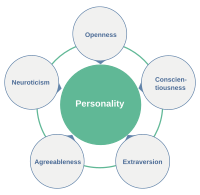
Validation of the Traumatic Antecedents Questionnaire using item response theory
Sign Up to like & getrecommendations! Published in 2020 at "Brain and Behavior"
DOI: 10.1002/brb3.1870
Abstract: Traumatic Antecedents Questionnaire (TAQ) is a traumatic experience scale that measures exposure to traumatic events across four age periods. Although the TAQ has good convergent validity with other traumatic scales, the classification of the domains… read more here.
Keywords: questionnaire using; traumatic antecedents; item response; validation traumatic ... See more keywords

Item response theory and its applications in educational measurement Part I: Item response theory and its implementation in R
Sign Up to like & getrecommendations! Published in 2020 at "Wiley Interdisciplinary Reviews: Computational Statistics"
DOI: 10.1002/wics.1531
Abstract: Item response theory (IRT) is a class of latent variable models, which are used to develop educational and psychological tests (e.g., standardized tests, personality tests, tests for licensure, and certification). We review the theory and… read more here.
Keywords: item response; theory; response theory; part ... See more keywords

Performance of longitudinal item response theory models in shortened or partial assessments
Sign Up to like & getrecommendations! Published in 2020 at "Journal of Pharmacokinetics and Pharmacodynamics"
DOI: 10.1007/s10928-020-09697-x
Abstract: This work evaluates the performance of longitudinal item response (IR) theory models in shortened assessments using an existing model for part II and III of the MDS-UPDRS score. Based on the item information content, the… read more here.
Keywords: response theory; item response; theory models; performance longitudinal ... See more keywords

Non-parametric measurement for patient-reported outcomes
Sign Up to like & getrecommendations! Published in 2022 at "Quality of Life Research"
DOI: 10.1007/s11136-021-03073-z
Abstract: We issued the call for the set of papers published in this special section in 2019 with the goal to illuminate innovative state-of-the-art methods for nonparametric measurement. The original idea for this call goes back… read more here.
Keywords: item response; response; quality life; research ... See more keywords

An item response theory analysis of the PTSD checklist for DSM-5: Implications for DSM-5 and ICD-11.
Sign Up to like & getrecommendations! Published in 2020 at "Journal of anxiety disorders"
DOI: 10.1016/j.janxdis.2020.102190
Abstract: The PTSD Checklist (PCL) is a widely used, extensively validated questionnaire for posttraumatic stress disorder (PTSD). The PCL was revised for Diagnostic and Statistical Manual of Mental Disorders, 5th Edition (DSM-5; Friedman, 2013), and the… read more here.
Keywords: response theory; item response; dsm; ptsd checklist ... See more keywords

Assessment of environmental sustainability perception through item response theory: A case study in Brazil
Sign Up to like & getrecommendations! Published in 2018 at "Journal of Cleaner Production"
DOI: 10.1016/j.jclepro.2017.09.217
Abstract: Abstract Sustainability perception can be understood as humans' awareness of the environment. This study assessed the sustainability perception of the Parana III Basin residents in Brazil through item response theory (IRT). For this purpose, a… read more here.
Keywords: response theory; item response; study; perception ... See more keywords

High agreement was obtained across scores from multiple equated scales for social anxiety disorder using item response theory.
Sign Up to like & getrecommendations! Published in 2018 at "Journal of clinical epidemiology"
DOI: 10.1016/j.jclinepi.2018.04.003
Abstract: OBJECTIVES There is no standardized approach to the measurement of social anxiety. Researchers and clinicians are faced with numerous self-report scales with varying strengths, weaknesses, and psychometric properties. The lack of standardization makes it difficult… read more here.
Keywords: response theory; item response; anxiety; scales social ... See more keywords

Introduction to bifactor polytomous item response theory analysis.
Sign Up to like & getrecommendations! Published in 2017 at "Journal of school psychology"
DOI: 10.1016/j.jsp.2016.11.001
Abstract: A bifactor item response theory model can be used to aid in the interpretation of the dimensionality of a multifaceted questionnaire that assumes continuous latent variables underlying the propensity to respond to items. This model… read more here.
Keywords: response theory; model; bifactor; item response ... See more keywords

An Introduction to Item Response Theory and Rasch Analysis: Application Using the Eating Assessment Tool (EAT-10)
Sign Up to like & getrecommendations! Published in 2017 at "Brain Impairment"
DOI: 10.1017/brimp.2017.31
Abstract: Item response theory has its origins in educational measurement and is now commonly applied in health-related measurement of latent traits, such as function and symptoms. This application is due, in large part, to gains in… read more here.
Keywords: analysis; response theory; item response; response ... See more keywords

Refining the assessment of disrupted maternal communication: Using item response models to identify central indicators of disrupted behavior
Sign Up to like & getrecommendations! Published in 2017 at "Development and Psychopathology"
DOI: 10.1017/s0954579417001778
Abstract: Abstract The Atypical Maternal Behavior Instrument for Assessment and Classification (AMBIANCE; Bronfman, Madigan, & Lyons-Ruth, 2009–2014; Bronfman, Parsons, & Lyons-Ruth, 1992–2004) is a widely used and well-validated measure for assessing disrupted forms of caregiver responsiveness… read more here.
Keywords: disrupted maternal; item response; communication; ambiance ... See more keywords

Examining hypothesized interactive and curvilinear relations between psychopathic traits and externalizing problems in an offender sample using item response-based analysis.
Sign Up to like & getrecommendations! Published in 2019 at "Journal of abnormal psychology"
DOI: 10.1037/abn0000462
Abstract: Fearless dominance (FD) generally manifests null to small relations with externalizing problems, leading some researchers to propose alternative paths by which FD features may relate to these problems. The current study provides a test of… read more here.
Keywords: sample; psychopathic traits; item response; curvilinear relations ... See more keywords